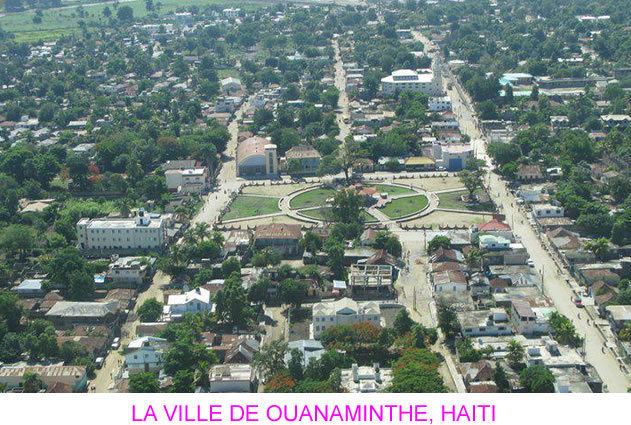Local time Monday 8:42 PM | Team Ouanaminthe FC | |
 | ||
Weather 24°C, Wind NW at 10 km/h, 94% Humidity Arrondissements Nord-Est, Ouanaminthe Arrondissement | ||
Ouanaminthe (Haitian Creole: Wanament or Wanamèt; Spanish: Juana Méndez) is a commune or town located in the Nord-Est Department of Haiti. It lies along the Massacre River, which forms part of the natural border between Haiti and the Dominican Republic. Ouanaminthe is the largest commune in northeastern Haiti. The bridge connecting Ouanaminthe to the Dominican city of Dajabón is one of the four main border crossings between the two countries. Throughout its history, the city has repeatedly been a site of conflict in international disputes, first between French and Spanish colonists, and in more modern times as part of the long-standing Haitian-Dominican conflict.
Contents
- Map of Ouanaminthe Arrondissement Haiti
- Etymology
- Education
- Medical
- Economy
- Communal sections
- Notable people
- References
Map of Ouanaminthe Arrondissement, Haiti
The population stands at roughly 100,000 people, including the immediate vicinity. Haitians living in Ouanaminthe are allowed to cross the border freely without documents two days per week, mainly for the market on Mondays and Fridays at Dajabón, where they buy and sell goods. In 2010, a new bridge and the new market store, funded by the European Union, was opened.
Etymology
The name Ouanaminthe is the French form of the Taíno word Guanaminto, which was the reported pronunciation of the name of the indigenous village that preexisted European settlement on the present-day town site.
The Haitian Creole form, Wanament, is simply the Creolization of the French name.
The Spanish form, Juana Méndez, comes from the name of the Haitian ex-slave Juana Méndez, the mother of Buenaventura Báez Méndez, the first mulatto President of the Dominican Republic.
Education
Ouanaminthe has many small schools. The majority of them belong to churches. Ouanaminthe has several elementary schools, including St-Francois Xavier, St-Francois d'Assise, CFCP, Sur le Rocher and L'institution de l'Univers congreganist schools. There are over 10 secondary schools, including a lycée, a public school, and a law school (public university). The Lycée Capois La Mort was located in the Arobouk nan gran ri a, and has now moved to Sans. Haiti's educational system is constituted of four parts:
Currently there are five new primary schools under construction, funded by Foi et Joie (Faith and Joy) under the patronage of Jesuit Refugee Service as well as Solidaridad Fronteriza.
The common local language is Creole (Kreyòl). Haiti's other official language, French, is also used.
Local travel is mainly by scooter or motorcycle. With the exception of the main streets, road surfaces are dirt, with numerous potholes. There is an intra-city bus station in town.
Medical
.
Economy
Canada has recently financed the renovation of the police station.
The town's primary economic activity is trade with neighboring Dajabon.
• Seeking to combat contraband and encourage domestic production, in 2015 Haiti banned the importation by truck of 23 items, including bottled drinking water and spaghetti.
Communal sections
The commune consists of five communal sections:
